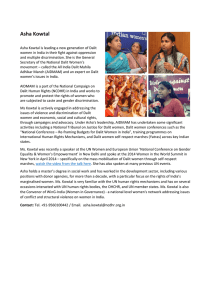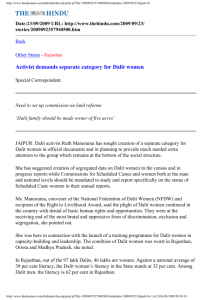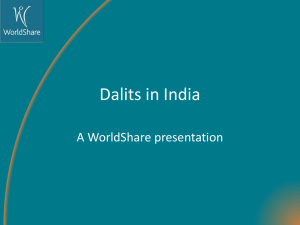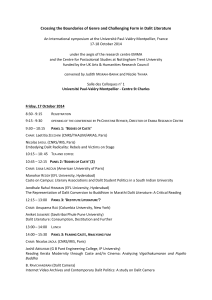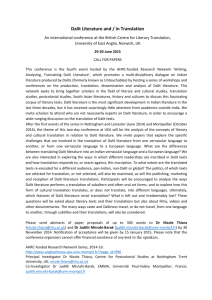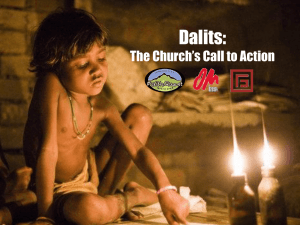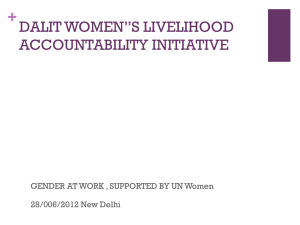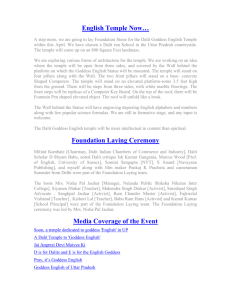Literature as a Vehicle for Social Transformation
advertisement
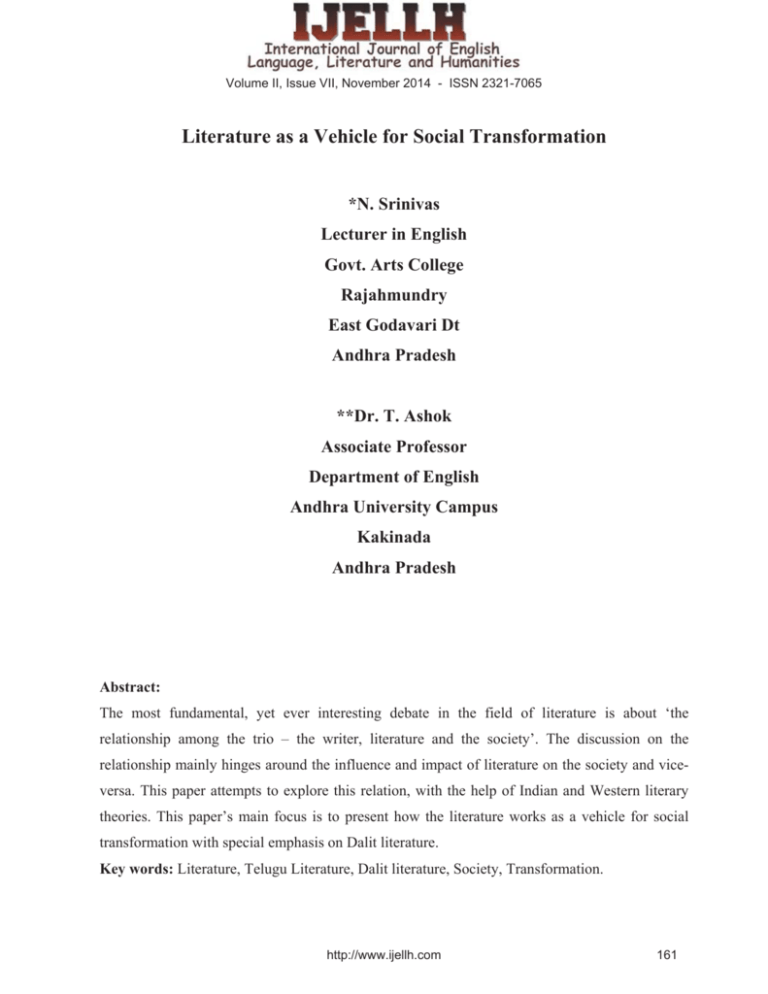
Volume II, Issue VII, November 2014 - ISSN 2321-7065 /LWHUDWXUHDVD9HKLFOHIRU6RFLDO7UDQVIRUPDWLRQ 16ULQLYDV /HFWXUHULQ(QJOLVK *RYW$UWV&ROOHJH 5DMDKPXQGU\ (DVW*RGDYDUL'W $QGKUD3UDGHVK 'U7$VKRN $VVRFLDWH3URIHVVRU 'HSDUWPHQWRI(QJOLVK $QGKUD8QLYHUVLW\&DPSXV .DNLQDGD $QGKUD3UDGHVK $EVWUDFW The most fundamental, yet ever interesting debate in the field of literature is about ‘the relationship among the trio – the writer, literature and the society’. The discussion on the relationship mainly hinges around the influence and impact of literature on the society and viceversa. This paper attempts to explore this relation, with the help of Indian and Western literary theories. This paper’s main focus is to present how the literature works as a vehicle for social transformation with special emphasis on Dalit literature. .H\ZRUGVLiterature, Telugu Literature, Dalit literature, Society, Transformation. http://www.ijellh.com 161 Volume II, Issue VII, November 2014 - ISSN 2321-7065 'HILQLWLRQRI/LWHUDWXUH In the Western view point, the word /LWHUDWXUe originally meant all written language. More formally, literature is defined by dictionaries as ‘writings in which expression and form, in connection with ideas of permanent and universal interest, are characteristic or essential features, as poetry, romance, history, biography, essays, etc. The equal term that is used for literature in India is ‘Sahithyam’. But, the word ‘Sahithyam’ connotes very specific and focused definition and meaning compared to its counterpart in English. The etymology of the word ‘Sahithyam’ is ‘Hithena sahitham Sahithyam’, i.e., Literature contains hitham – meaning betterment, goodness, welfare, etc. Thus, the word Sahithyam itself indicates that the main purpose of literary work is to provide welfare or benefit to the society or to act as an agent of transformation for betterment of the society. It is true that most of the earlier literary theories view literature as poetry only, as that used to be the only or the dominant genre of literature. But, the literary theories and definitions that were given for poetry are equally applicable for other forms such as drama, short story, novel, literary essays, etc. 6RFLDOSXUSRVHRI/LWHUDWXUH The discussions related to the relationship between the literature and the society, mainly focus on the purpose or utility of literature in human life. Literature is the artistic form of human life. A writer plays his role in that field. Hence, his writing is not purposeless. Maxim Gorkey says that “three people build the culture – the Scientist, the Artist and the worker”. Here the term Artist includes a literary writer also. Thus, a writer becomes a partner in the building of culture. But, the culture the poet builds depends on the period he lives, the then social system, etc. 9LHZVRIVRPH:HVWHUQZULWHUVRQWKH3XUSRVHRI/LWHUDWXUH In his ‘Poetics’, Aristotle tries to prove that the literature ‘is true, serious and useful’. He further says that a poet is like a painter, an imitator. Hence, he must represent things either as they are or were, or as they are said to have been or ought to be in the society. This clearly shows the direct relationship between literature and society. http://www.ijellh.com 162 Volume II, Issue VII, November 2014 - ISSN 2321-7065 Philip Sidney, in his book “An Apology for Poetry”, defended poetry (literature) with the support of accepted old argument that “imaginative literature can be justified if it communicates historical or philosophical or moral truths in a lively and pleasing manner”. P.B. Shelley, an English poet and literary critic praises the poets saying that the “Poets are the unacknowledged legislators of the world.” They lay down the order in which the working of the society should be carried on for the greatest good of the greatest number. They lay down law for the people and paint the picture of an ideal society for implementation. In Shelley’s opinion, “poetry can serve as a medium of social reform and an instrument to bring about regeneration of mankind in future. The poet is a prophet who peeps into the future and can bring about betterment of human life in times to come. Shelley did not believe that the function of poetry was to impart artistic delight only. According to him, poetry can have a perceptible design and can function to promote the well-being of human society. Coleridge praises Shakespeare saying “Myriad-minded Shakespeare held mirror to nature” (Here nature refers to human nature). Literature mirrors life and society. The literature of any period reflects its social system. If the literature of ancient time reflected the lives of the minority, literature of present times reflects the lives of the majority. That is the only difference. But, in all the times, literature didn’t stop reflecting the society. 6RFLDO3XUSRVHLQ7HOXJX/LWHUDWXUH Generally, the literature is said to have two purposes: pleasing and instructing. Right from the beginning, most of the Telugu writers were clear in the purpose of their writing. Telugu poet Errana praises Valmiki, saying that he removed the animalistic natures of human race by writing the Ramayana. This is what meant by artist being the builder of culture. In his Andhra Shabdha ChinthAmani, Nannaya says that literature looks at the benefit and welfare of the universe (Vishwa shrEyah kAvyaM). Other ancient writers also expressed similar opinions. But, what is the universal welfare or social welfare they looked at? It was the establishment or protection of the Vedic system and the Varna system. The Well-known Shaivite poet Palkuriki Somana declared that he was writing for the commoners. He used contemporary themes and janu Telugu (the commoners’ language). Somana opined that the literature should fulfill the contemporary social needs. He criticized the Varna http://www.ijellh.com 163 Volume II, Issue VII, November 2014 - ISSN 2321-7065 system and inequalities, thus viewing the social activism as the purpose of literature. But, in the later times, physical pleasure became the prime purpose of the literature. Thus, the social perspective of literature which was first seen in Nannaya slowly dwindled, though some Shataka poets and Padakavis were exceptions to this trend. They lived far away from the King and lived nearer to the God. People’s poet Vemana criticized his contemporary society in several ways. Sumathi shathakam taught many morals and life skills. Kavi Choudappa criticized the spoilt society of his time. Padakavis like Annamayya chose the path of Pothana and kept faith in the God only. Until the entry of Kandukuri Veeresalingam Panthulu, the literature stayed away from the social purpose. The social characteristic of literature was simply forgotten. 0RGHUQ7UHQGVLQ7HOXJX/LWHUDWXUHDQGWKHLULQIOXHQFHRQ6RFLHW\ In the last century, different trends and movements have enriched the wealth of Telugu literature. Some of the movements and their influences, in brief are as follows: L The Bhavakavithva Udyamam poets, lead by Devulapalli Krishna Shastry, took the English Romantic poets as their models. They rejected the complex poetic prosody (Chandas) and preferred simple forms like lyrics and Khandikas. LL The Abhyudaya Kavithva Udyamam (Progressive Poetry movement), mainly lead by Sri Sri tried to bring the ideologies of Socialism and Communism into poetry. LLL The Digambara Kavithva Udymam (Naked poets), lead by Cherabandaraju, Nikhileshwar, and others criticized vehemently the hypocrisy in traditional Telugu poetry. With the usage of vulgar and colloquial language, they shocked the Telugu literary world. LY The two movements which emerged simultaneously in 1980’s are – the Feminist movement and the Dalit movement. It can be said that these movements emerged due to the failure of progressive and revolutionary movements in accommodating their voices and recognizing the plurality of Indian society. While the Feminist poetry brought out the voices of women writers on their identity issues, the Dalit poetry ventilated the voice of the Dalit writers, the writers from the oppressed downtrodden communities like SCs and STs. http://www.ijellh.com 164 Volume II, Issue VII, November 2014 - ISSN 2321-7065 'DOLW/LWHUDWXUH±,QGLDQ6FHQDULR Dalit Literature is the literature which is concerned with the socially underprivileged, and which asserts the socio-political stature of the downtrodden and the oppressed. Though the novels of Mulk Raj Anand like ‘Untouchable’ were the first literary works to touch upon the plight of the outcast, the Dalit movement, in its present form, was started in literature by Marathi, Gujarati and Kannada writers under the leadership of Dr. B.R. Ambedkar. It is a literature of militant protest against upper caste literature upholding Brahmanical values. 0DLQIHDWXUHVRI'DOLW/LWHUDWXUH Dalit literature is a new literary norm with an evident disregard for form, content and style, and a vibrant expression of the newly awakened sensibilities which distinguishes it from the mainstream literary traditions. Other main features are as follows: L It is a literature of protest against all forms of exploitation based on class, race, caste or occupation. It primarily focuses on fundamental human rights and human values; LL It rejects both the Western and Eastern theoretical conceptions like Freud’s Psychoanalysis, Barthe’s Structuralism and Derrida’s Deconstruction together with the Indian theories of Rasa and Dhwani. It attempts to develop Dalit aesthetics; LLL It questions and de-constructs the very foundations of Indian Mythology. In their search for alternatives, Dalit writers have rediscovered the low caste poets of the Bhakti movement. Even they found relevance in Buddhism; LY The Dalit writers consider the legendary figure Ekalavya as their forefather and Shambooka- another Dalit in Ramayana who was killed by Rama at the behest of Vasishta, is worshipped by them; Y Authenticity and liveliness are hallmarks of Dalit literature. The Dalit writers express their experiences in stark realistic manner by using their native speech. Their language as well as images comes from their experiences instead of their observation of life. Dalit literature gives genuine descriptions of untouchability and poverty in a coarse day-to-day spoken language; http://www.ijellh.com 165 Volume II, Issue VII, November 2014 - ISSN 2321-7065 YL The Dalit literature imbibes “Dalit Consciousness”, a consciousness of their own slavery, an understanding of their experiences of exclusion, subjugation, dispossession and oppression down the ages; YLL Shame, anger, sorrow and indomitable hope are the stuff of Dalit literature. Because of the anger against the age-old oppression, the expressions of the Dalit writers have become sharp. It is more seen in poetry than in any other genre; YLLL The Dalit writers found inspiration in the movement of blacks in the distant lands of North America and Africa; L[ The Dalit writers reflect the anguish of a community, and demand the shaping of a just and realistic future for the underprivileged and the outcast in society. The important writers of Dalit literature in India are: Mahasweta Devi, Namdeo Dhasal, Daya Pawar, Arjun Dangle, Sachi Rautray, Rabi Singh, Basudev Sunani, Bama, Abhimani, Poomani, Imayam, Perumal Murugan, Palamalai, Yendluri Sudhakar, and others. 'DOLW/LWHUDWXUHLQ7HOXJX Dalit literature in Telugu finds its roots in the heart rendering poetry of Gurram Jashua. He marked a new beginning in the Telugu literature with his well known poetic creation ‘Gabbilam’. Kusuma Dharmanna and Boyi Bheemanna also belong to the first generation of writers who produced literature with Dalit consciousness. However, the Dalit literary movement in Telugu gained momentum in 1980’s after the Karamchedu and Tsunduru (Chunduru) incidents where the Dalits were massacred by the upper caste people. From this period, Dalit’s protest and an alternative vision started reflecting in Telugu literature. Writers of the Dandora movement, for example, who belong to the Madiga caste, have begun adding the caste name to their surnames, a practice hitherto followed only by the upper castes. Famous Telugu Dalit writers of the second generation include: Kolakaluri Enoch, Siva Sagar, Gaddar, Boya Jangaiah, Chilukuri Devaputra, Kathi Padmarao, Bojja Tharakam, Endluri Sudhakar, Vemula Yellaiah, G. Kalayana Rao, Satish Chandar, Madduri Nageshbabu, Kalekuri Prasad, Gogu Shyamala, Jupaka Subhadra, Jajula Gowri, MM Vinodini, Sujatha Gidla, Thullimalli Wilson Sudhakar, Challapalli Swarupa Rani, Sikhamani, etc. http://www.ijellh.com 166 Volume II, Issue VII, November 2014 - ISSN 2321-7065 The stream of Dalit literature has now become very wide by accommodating the most oppressed Dalit communities like ‘Rellis’, who have been fighting for their rights within the oppressed. The first anthology of poems in ‘Relli’ language, “DalithullO Dalithulu” was penned by Mangalagiri Adithya Prasad. 5ROHRI'DOLW/LWHUDWXUHLQ6RFLDO7UDQVIRUPDWLRQLQ$QGKUD3UDGHVK Compared to any other literary movement in the last century, Dalit literary movement is said to have brought a sea change in the content and form of Telugu literature. It has also been acting as a vehicle for achieving social transformation. The rich and vibrant Dalit literature includes varied forms such as poetry, lyrics, stories, dramas, literary essays, etc. The Dalit literature wishes to change the world by bringing the humanity to the forefront. The following are the visible results and transformations brought by the Dalit literature, in the area of literature in specific, and in the society in general: L First and foremost, it effectively threatened the Brahmanic supremacy from literature; LL It stimulated Dalit masses for assertion, protest and mobilization; LLL It stirred up thinking in Dalit intellectuals and catalyzed creation of organic intellectuals of Dalits; LY It is highlighting the atrocities on the Dalits through different forms, thus enlivening the issue until the sufferers meet the justice; Y It brought in a new set of Dalit aesthetics, in opposition to the age old, traditional poetics; YL It has motivated many poor Dalits for pursuing higher studies and opting better careers; These days, the Dalit literature is playing influential role in laying the theoretical ground for welfare schemes and protection measures, by bringing different issues for discussion in the literary forums. Thus, it is enabling the policy makers to create required statutory acts. One of such examples is the recently drafted SC-Sub Plan expenditure scheme which aims at spending the funds allocated for upliftment of the SCs, exclusively for them. Dalit Literature is the best example to show that the literature’s primary purpose is social transformation. http://www.ijellh.com 167 Volume II, Issue VII, November 2014 - ISSN 2321-7065 5HIHUHQFHV Aristotle, “Poetics”. Philip Sidney, “An Apology for Poetry”, Rama Brothers, June 1988. Shelley, P.B., “A Defence of Poetry”, Student Store, Bareilly, 1975. “Sahithyabhiprayalu – Abhiruchulu”, Telugu Academy, 1990. “A Critical Study of Dalit Literature in India”, Dr. Jugal Kishore Mishra. “The Dalit Vision and Voice: A Study of Sharan Kumar Limbale’s Akkarmashi”, Mini Babu, The Criterion, December 2012 (www.the-criterion.com ) http://www.ijellh.com 168
